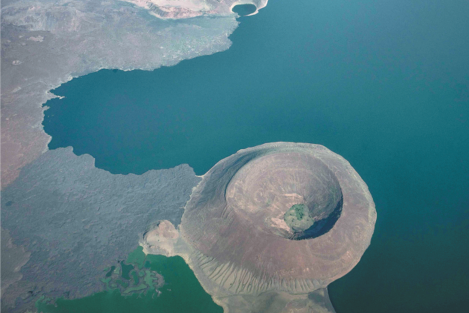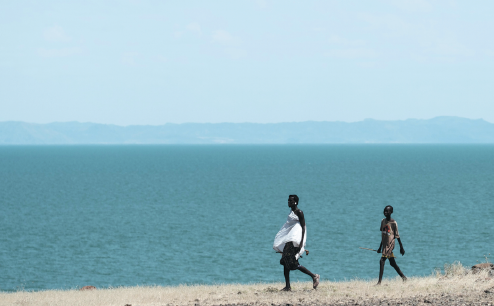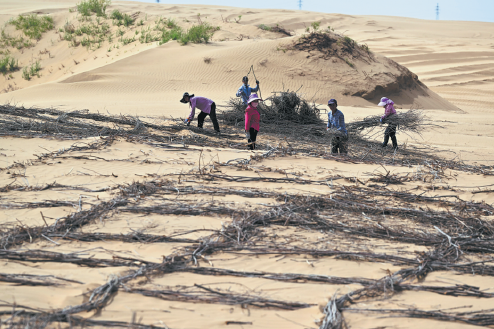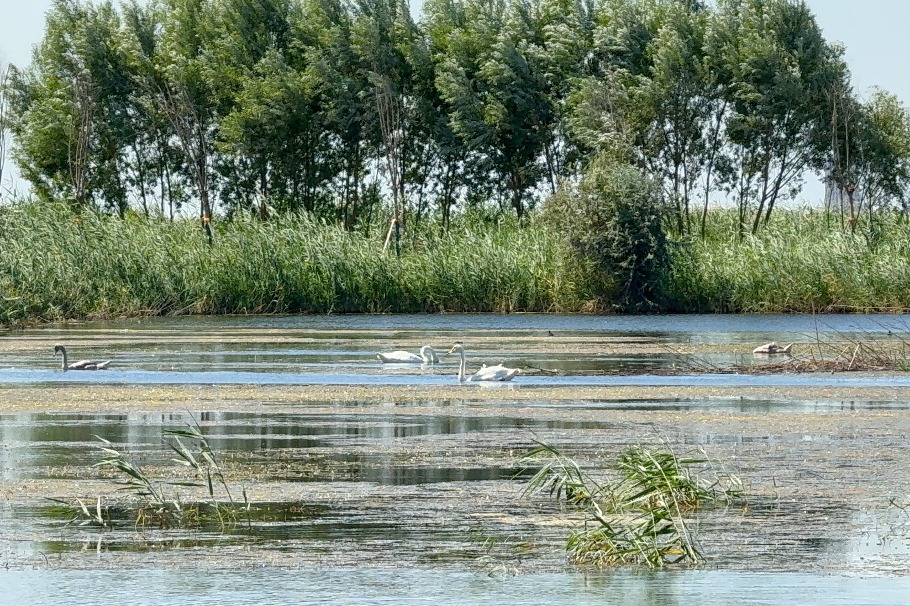In Kenya you'll find much more than lions and elephants
From animal reserves to a site of ancient civilization, lakes and beautiful marine life, the East African country has so much to offer tourists

Kenya is famed for its world-class long-distance athletes, scenic game reserves and picturesque beaches.
The country also has many other things worth getting to know, many off the beaten track. It was East Africa's leading tourist destination with more than 1.5 million international visitors last year and offers tourists a wide variety of adventures in both rural and urban areas.
One of the hidden gems is Lake Turkana, the world's largest permanent desert and alkaline lake, in the country's far north. The lake serves as a pit stop for migrant waterfowl and is a major breeding ground for the Nile crocodile. It also hosts a variety of venomous snakes as well as hippopotamuses.
While in the area, visitors have access to Sibiloi National Park, South Island National Park and Central Island National Park, with flora and fauna covering 161,485 hectares. The Lake Turkana National Park site was inscribed on the United Nations World Heritage List in 1997, and in addition to serving as a tourist destination it has been identified as an outstanding laboratory for the study of plant and animal life.
While in the area, tourists can visit Nariokotome village near the shores of Lake Turkana, where the remnants of the Turkana Boy were found, a near-complete skeleton of a 1.6-million-year-old Homo erectus, which has given Lake Turkana the moniker "cradle of mankind".
A commemorative pillar and a brass replica of the Turkana Boy mark the spot where researchers discovered the fossil in 1984. Lake Turkana's status as a notable archaeological site was cemented by the discovery in 2011 of some of the oldest known stone tools, believed to have been in the area for 3.5 million years.
Further south of Lake Turkana visitors interested in seldom-visited attractions will find the Samburu National Reserve. It teems with rare species of animals such as the Grevy's zebra, the Somali ostrich, the gerenuk, the reticulated giraffe and the beisa oryx.
In addition to these rare species, visitors also have a chance to view other animals because it is home to at least 900 elephants as well as large predators such as lions, leopards and cheetahs. Wild dog sightings are also common in this protected area.
Central to the Samburu National Reserve's ecosystem is the Ewaso Ng'iro River, on which visitors can take a safari in inflatable rafts. The river's banks are also dotted with the larger grazers found in the reserve such as impalas, buffalo and hippopotamuses.
The Samburu National Reserve is also seen as a bird watcher's paradise because it hosts more than 450 species of resident and migrant birds. With a good pair of binoculars and the help of park guides, anyone passionate about all birds or those who just enjoy seeing the colorful ones will be delighted by the abundance of plumage in the reserve.
On request, visitors to the reserve can also enjoy a visit to a Samburu village to interact with members of the Samburu tribe and get a glimpse of their culture and way of life.
Chyulu Hills, closer to Nairobi, Kenya's capital, presents another lesser-known but naturally endowed tourist destination. Even though it receives far fewer visitors than flagship wildlife destinations in the country, Chyulu Hills was ranked among the top 50 places to visit worldwide this year by the Times magazine.
Spectacular landscape
Fondly referred to as the Green Hills of Africa, Chyulu Hills is famous for its spectacular landscape comprising endless rolling hills covered in green vegetation. In addition to being one of the best places to view Mountain Kilimanjaro, Africa's highest mountain, Chyulu Hills is also famous for its Leviathan cave, believed to be the longest and deepest known lava tube in Africa.
With volcanic cones and cylinders providing striking views of previous lava flows in the area, Chyulu Hills is believed to have had its last volcanic activity 20 years ago. The porous nature of resultant lava rocks has helped keep neighboring areas abundant with fresh water, thus providing perfect sanctuary for the area's abundant wildlife.
Among the animals that inhabit this unique ecosystem are large mammals such as buffalo, bushbucks, elands, elephants, giant forest hogs, bush pigs, reedbucks and giraffes along with various reptiles and insects.
Those who love hiking will enjoy Chyulu Hills. Hiking can be undertaken on various animal trekking trails that lead explorers to the mountain ranges, where the majestic Kilimanjaro comes into clear view.
The hiking trails also offer a good opportunity for mountain biking that can be done along the rugged landscape. Horse riding is also another way of exploring the pristine wilderness and all of its animals.
Visitors to the park do not have to worry about accommodation because thatched cottages can be found at the foothills of Chyulu Hills National Park, spreading across a gentle slope on the 111,000-hectare Mbirikani Group Ranch. The ranch is built on community land owned by 4,000 Maasai community members, and the cottages are built with ancient lava rock, the product of volcanic activity in the area.
In Kenya's west lies yet another glorious but less visited destination in the country, the Kakamega forest reserve. For visitors fascinated with Africa's historical connection with forests and dark jungles, this forest reserve offers an opportunity of being transported to the Africa of ancient times.
The reserve, considered the last primeval rainforest in Kenya, is a small remnant of a much larger forest system that once stretched across Central and East Africa. However, much of that forest was felled in recent centuries and the land was used for cash crop farming.
The forest is on undulating terrain at an elevation of between 1,500 meters and 1,600 meters close to the border with Uganda and is a watershed of two rivers that flow through the forest before emptying into Lake Victoria, Africa's largest freshwater lake.
The Kakamega forest reserve is not only famous for its thick canopy of tropical rainforest but is also a location of amazing biological diversity. Within the forest, visitors can spot several animals such as monkeys, forest squirrels, pangolins, giant forest squirrels, hammer-headed fruit bats and bushpigs.
The forest is also home to numerous species of birds, snakes, insects and butterflies that are all interconnected and play a part in supporting the forest's ecosystem by spreading the seeds of the trees and pollinating the flowers.
One of the best ways to enjoy the wonders of the Kakamega forest reserve is by indulging in a walking safari. Hiking trails allow visitors to be intimate with the thick swath of nature that abounds in the forest. Rangers of the Kenya Wildlife Service can guide visitors on their walks and in activities such as bird-watching, nighttime safaris and trips to the numerous falls and lookout points within the forest.
Sea creatures
Because Kenya is renowned for its bush game drives, many tourists miss out on the fact that the country is also endowed with a rich marine environment that includes coral reefs, fisheries, mangrove forests and sea grass.
Along the coastal area of the country's south, visitors can find the little-known Kisite-Mpunguti Marine National Park. This park, a sanctuary of coral reefs and small islands, is home to dolphins, turtles, innumerable fish and sea birds. It also features incredible natural formations, colorful habitats and limitless sea life.
The marine park was established as part of efforts to protect the scenic islands and special habitats of a wide range of endemic marine animals and breeding migratory birds that inhabit Kenya's coast. It was designated as a marine protected area in 1978.
The marine park is home to more than 45 types of coral and 360 fish species such as grouper, puffer fish, blue-lined snapper, butterflyfish, triggerfish, turtles and dolphins. Marine lovers also have the opportunity to see blue parrotfish, octopus, clams, sea cucumbers and reef sharks, and between July and December they may spot migrating humpback whales that nurture their calves in these clear, warm waters.
With seven dive sites ranging from 2 meters to 32 meters, the marine park offers an excellent spot for beginners as well as more proficient divers. Visitors can also make a stop at Kisite Island, decked with a beautiful beach. The island plays an important role as a habitat for bird species in the area, and visitors can see colonies of roseate and sooty terns breeding on the island in July.
Furthermore, explorers can visit ancient coral caves that for centuries have acted as sacred sites of worship for local communities. These sacred caves are laden with historical significance because in the 18th and 19th centuries they became holding pens for captured slaves on their way to the slave markets of Zanzibar.



Today's Top News
- Exemplary vision drives development
- Lasting bond honors Flying Tigers legacy
- Monetary easing to persist in near term
- Trump, Zelensky, European leaders hold multilateral talks
- China firmly reaffirms sovereignty over Taiwan
- A-share market surges past 100 trillion yuan milestone






























